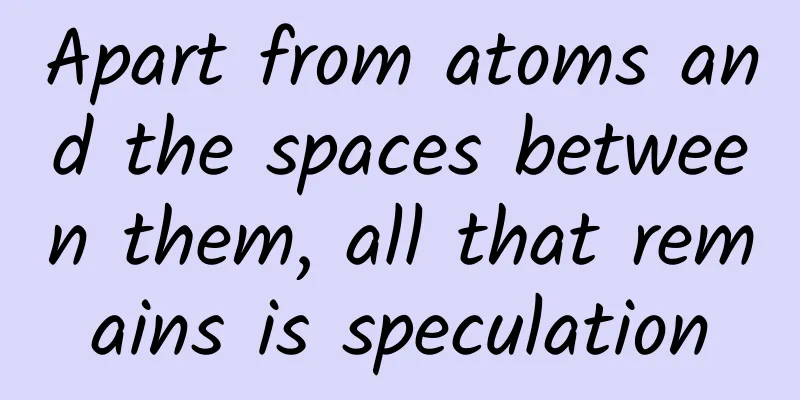Apart from atoms and the spaces between them, all that remains is speculation

|
© Vulture Leviathan Press: Sand is something between solid and liquid. It is indeed difficult to find objects with similar properties in daily life. And this wonderful property is entirely due to time - every inconspicuous grain of sand has seen countless changes of time. From this point of view, the ever-changing world that we often lament has never actually happened. Everything will eventually return to dust, but the sand has always been there. This easily reminds people of the protagonist's fascination and fear of "beginningless and endless" in Borges' novel "The Book of Sand": each page of the mysterious holy book only appears once in the eyes of the observer in time, and then disappears. Even if you turn to that page again, "I want to burn it, but I am afraid that an infinite book will burn endlessly." Apart from atoms and the spaces between them, all that's left is speculation. —Diogenes Laertius, Democritus Wind-blown sand ripples at Southbourne, from Waves of Sand and Snow by Vaughan Cornish, 1914. © archive Grit is everywhere and endless, just like fog, smoke, dust, snow, sugar, cinders, sleet, soap, syrup, mud, toffee...although it is rarely mentioned, it is everywhere. Such substances sometimes gather and sometimes disperse, and even when separated from themselves, they can always gather together. Of all suspicious things, sand is undoubtedly the most untrustworthy and the most fickle. No one would really want to stand on the clouds, but sand has betrayed many architects and buildings. Sand can either become part of a building or destroy it. In an 18th-century sequel to the adventures of Baron Munchausen, Baron’s crew encountered a sandstorm and dug a dome-shaped sand house to shelter from the storm, then escaped by tunneling underneath it. Sand can engulf an object, blur its outlines, and erode its edges and protrusions. Sand is the ultimate threat to the permanence of stone, because it is just another form of stone, atomized and worn away. In Shelley’s Ozymandias, the great statue of Rameses is imagined dismembered in the Egyptian sands. The fragments of head, legs, and base foreshadow further shattering, and the flatness that will follow when the debris is completely worn away: “Around the ruin, nothing but grains of sand, stretched out lonely and calm into the desolate distance.” Daguerreotype of the Tomb of Ramses II (c. 13th century BC) by Joseph-Philibert Girault de Prangey, 1844. © wiki The painting, Fragments of the Great Colossi at the Memnonium, is based on a watercolor by David Roberts, taken from an engraving by Louis Haghe, Egypt and Nubia (1847). © clevelandart There is no doubt that quicksand is dangerous. The prefix of the word (quicksand) indicates that it has enough vitality and can easily trap the unwary. Quicksand makes the already uncertain substance even more suspicious. It is hard and soft, like fine sand soaked by liquid, wet in some places and dry in others, loose and sticky like syrup. In his account of Pierre Gassendi’s Neoatomism, Walter Charleton used quicksand as a metaphor for the contradiction between all matter: “the restless revibrations of atoms, and even of other bodies compacted together, at a few points in a vast space, like the intertwining of bees in a swarm, must be eternal, and therefore they must never cease, even in the hardest concrete… Nothing is more tranquil, and yet nothing is more passionate than quicksand.” Sand is also a source of acceleration. Sweat or spit on the sand can breed mites and fleas. Mythological creatures are often portrayed in the form of sand, like Zôba'ah in The Djinns, who can blow sand into columns. In Cornish folklore, the spirit Tregeagle is sentenced to endless toil, building a sand truss, tied with similarly sandy ropes, to carry it from the water to the rocks: the roar of the storm is said to be his cry of anger as the waves continually destroy his work. In E. Nesbit's 1902 book Five Children and It, the irritable Psammead, or Sand Fairy, is found by a group of children in a sandpit. She can grant wishes by growing larger and then shrinking back to her original size. The book explains that Sand Fairies are rare now because they once lived in the sand castles that children built at the seaside, but because the castles kept flowing into the sea, almost all of them died. “The Dust Whirl,” from Élisée Reclus’ The Ocean, Atmosphere, and Life (1873). © archive Illustration by H.R. Miller for Nesbitt's 1905 edition of Five Children and It. © lcweb2 Sand is reversible and pours as smoothly as milk when completely dry. In ancient times, people used sand baths to treat rheumatism and also used it as a sauna to sweat. Sand is a product of wear and tear, but it is also an abrasive in its own right and can be used for sandblasting, etching and grinding. Pliny tells us that using sand saws can make marble cuts more perfect, so that they can be better polished and carved. Sand symbolizes neutrality, indifference, and unity, but it also has hair-trigger sensitivity and responsiveness. A grain of sand (often actually a tiny parasite) can stimulate an oyster to secrete a pearl. Sand has a close relationship with sound, making a hoarse sound in the throat of the wind and being the ear itself. In 1787, German physicist Ernst Chladni demonstrated that drawing a violin bow on a metal plate and sprinkling it with fine sand could produce sacred sounds, such as trembling mandalas and rippling lutes. Although sand can disfigure people and swallow up life, it can also reveal the movement of the wind and the vibrations of the earth. It is a detection and reception mechanism that can form ridged isobars, trembling forms, air sculptures, and oscilloscopes of gusts. Extract from Ernst Charardi’s Discoveries in the Theory of Sound, 1787. © Max Planck Institute Sand can participate in people's dreams. The Sandman can make children fall asleep by blowing sand into their eyes. But the sand does more than just seal the eyes, because in many versions of this fairy tale, sand is the raw material of dreams, and the Sandman will put narcotics, swirls and particles in his bag with it. In Top Hat (1935), Fred Astaire tap-danced Ginger Rogers to sleep by spreading sand on the floor of a hotel room. The origins of the moonwalk can be found in the sand-stage performances of music hall performers such as Wilson, Keppel and Betty. Although it sounds paradoxical, sand also has a good or bad omen. The Arab people have a way of divination by throwing a handful of sand and using a crystal ball. It is called ilm al-raml, which means the science of sand or psammomancy in Greek. Sand is ephemeral, the most temporary of materials. It is a symbol of time, seemingly ever-changing yet never changing. It seems to be a collection of years, polished and piled up, with each grain of sand like the atoms that make up time, passing away one by one. Sand is featureless, with no joints or cracks, even though it is always breaking apart. However, it is this property that makes it possible to measure time, because unlike other materials, sand can flow regularly even as its volume is decreasing. Sand-glasses were used mostly to measure time at sea, far from any landmarks; speed could be calculated by counting the time it took for sand to pass through the hole in the glass and the number of knots in the rope that stretched out from the stern. The instrument used to measure half-hours, the so-called "glass", was also measured in this way. Grains of sand in the form of quartz crystals, with their precise vibrations, still regulate our time at the microscopic level. In fact, the sand in the hourglass is usually not quartz sand, but marble or pebble particles. But we find a strong affinity between sand and glass, because silicate, one of the components of sand, is an important raw material for making glass. George Herbert wrote: "The body is like glass, which can hold dust (gravel) / measure our time; but it will eventually turn into dust." And for Gerard Manley Hopkins, the soul itself is "gentle grains of sand / that trot, ever moving, drifting / in the hourglass against the wall, / now crowded, now tottering." Detail of the allegory of temperance, from Ambrogio Lorenzetti's fresco The Allegory of Good and Bad Government in the Palazzo Publico in Siena, c. 1338. © wiki When sand is incorporated into filmmaking, the film is attracted by the shimmer and illusion of sand. Grain is one of the characteristics of film, which is formed by tiny metallic silver particles on the surface of the photosensitive silver halide. This texture can distinguish analog images from digital images. Yet grain also tells us something about the compositional similarity between film and sand, namely the ability to create the illusion of a continuously changing wave from a mass of discrete, unrecognizable details. Strictly speaking, all apparently analog forms are smooth accumulations of numbers, that is, discontinuous forms, like the illusion of motion created by multiple images on a film strip. The sliding of sand, the process of creating abrasives from a multi-molecule assembly, is essentially film. Glass is just another form of sand, and by shooting sand through a glass lens, the film seems to have found the basic rules. The crescent-shaped dunes, like razor-cut dunes, are like the source of light itself in the contrast of light and dark. Tangled by the wind, washed by the sea, and hit by the long waves of the sun, the sand piles up and collapses in a sigh. This is the stage of illusion, the aurora on land. Following the gaze, the rock formations and cliffs were eroded along the way, rolling up the hot edges, surging with the ripples of the waves, gurgling, the small pool dried up in an instant, the cliffs collapsed gently, and after the painful disaster, the eye sockets suddenly trembled, the eyelids slowly closed, and the shutters fell. Never become less, and never become more, never repeat the same mistakes, start meditating right now, no matter it is more or less, the long camel hump roll records everything, when you turn to a broken page, sort it out, sift it, move forward with the sand, never stop re-examining yourself, keep moving forward, the desert is originally an immeasurable sum. About the author: Steven Connor is Professor of English, Director of the Centre for Arts, Social Sciences and Humanities and a Fellow of Peterhouse at the University of Cambridge. His most recent books include Dream Machines (Open Humanities Press, 2017), The Madness of Knowledge (Reflections/University of Chicago Press, 2019), and Backing Out: Reflections on an Unappreciated Character (Stanford University Press, 2019). By Steven Connor Translation/Sodium Potassium Proofreading/Chenpi Original article/publicdomainreview.org/essay/the-dust-that-measures-all-our-time This article is based on the Creative Commons License (BY-NC) and is published by Sodium Potassium in Leviathan The article only reflects the author's views and does not necessarily represent the position of Leviathan |
>>: The Aesthetic Value of Scientific Experiments
Recommend
Should I learn Swift or Objective-C directly?
[[120413]] After we released the Swift language l...
Take some melatonin when you can't sleep? 4 misunderstandings about insomnia medication, experts from West China University of Political Science and Law urge you to be cautious!
Facing the epidemic, Chengdu people are very stub...
iQIYI i71 VR all-in-one experience: You can watch "The Rap of China" live without a mobile phone
What kind of VR device can be truly accepted by t...
Can you buy near-expiry food at a 10% discount? Is it safe?
Hello, this is Science Popularization China. When...
Does the death of Qvod P2P have anything to do with porn trafficking?
This week, Kuaibo, which was supposed to be compl...
#千万IP创科普# Can you tell by the legs? The Minnan people teach you how to distinguish the "three cephalopod brothers"
📙Reading tips: The content comes from the diction...
Kaifeng, an underestimated ancient capital?
Kaifeng “Ancient Capital of Seven Dynasties” The ...
Time travel is no longer a dream? Scientists successfully simulated a "holographic wormhole"!
Recently, scientists have created News about &quo...
Electric Technology Car News: When the SUV market is hot, crossover cars are quietly rising. Can the more life-oriented Dongfeng KX successfully set a benchmark?
I don't know when crossovers started to becom...
The automotive cockpit chip market is in fierce competition, MediaTek + Nvidia want to surpass Qualcomm
During the auto show, the debut of the 3nm Dimens...
Channel operation: How to operate a product well when funds are insufficient
Insufficient funds is a common problem faced by m...
Several methods to implement delayed operation in Android development
Using Handler and Runnable The Handler class can ...
A picture to understand the front-end performance optimization of Html5
Overview 1. PC optimization methods are also appl...









